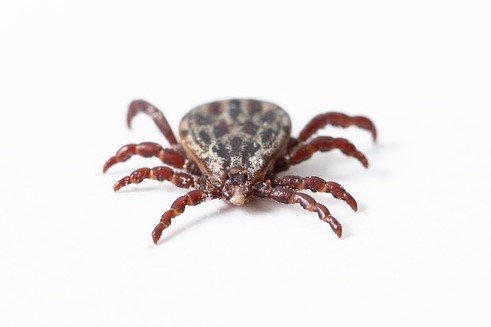This post contains affiliate links. If you click on a link and make a purchase I earn a commission at no extra cost for you.
Tick populations have been increasing dramatically in the last couple of years. With the increasing number of ticks, the risk for humans and pets to contract diseases transmitted by ticks has gone up too. Frontline is known to pet owners as an effective spot-on product for tick control. The active ingredient Fipronil acts directly on the nervous system of ticks and other blood-sucking pests. Fipronil is a so-called antiparasitic. So to the question: does frontline repel ticks? Not really repel, but it kills ticks when they get in contact with it.
How Does Frontline Repel Ticks?
As an antiparasitic, Frontline does kill ticks, fleas, and other pests that get in contact with it. The active ingredient Fipronil is fat-soluble and as such is absorbed and stored in the oil glands ( sebaceous glands) which are under the top layer of the skin (epidermis). From here it is slowly released from the glands to the skin and fur.
What is Fipronil?
Fipronil is an insecticide. It acts as a contact poison and kills ectoparasites that are common in pets such as fleas, chewing lice, ticks, fur mites, autumn grass mites, and mange mites.
If a pet treated with Fipronil (the active ingredient in Frontline) is infected with parasites such as fleas or ticks, they inevitably come into contact with the insecticide. As a contact poison, the active ingredient penetrates the parasite’s nervous system via the exoskeleton. Here it inhibits certain nerve receptors and blocks chemical substances (chloride ions) from transmitting nerve stimuli. The fipronil-specific inhibition of the GABA receptor only takes place in invertebrates, in mammals, birds, and reptiles the agent does not develop a comparably strong effect in this regard.
How long does it take for frontline to work?
When a tick comes into contact with the skin or fur of the treated animal, fipronil interferes with the nervous system of the bug and kills the parasite. Ticks do not have to bite the pet for Frontline to work. Being in contact with fur and skin is enough to be effective. When applied as recommended Frontline kills ticks in about 24 to 48 hours.
No products found.
How to use Frontline?
Frontline is available for dogs and cats, all animals in a household should be treated. Frontline should be applied once a month. Part the fur in the neck or between the shoulder blades until the skin becomes visible. Place the pipette tip directly on the skin and empty completely.
Is Frontline safe?
Studies of Frontline over the years have shown no evidence that Frontline causes cancers in pets. The dose of the active ingredients in Frontline is very low and when used as recommended considered harmless to the pet, but still lethal to fleas and ticks. However, some dogs have been observed to be mildly allergic to Frontline.
Side effects are possible with any kind of medication, as the metabolism of each individual may react differently. Whenever using a medication you need to balance the risks (side effects) with the benefits (preventing tick-transmitted diseases).
Side effects always sound alarming, fortunately, they are very rare. If Frontline is used as recommended it is very safe and effective in keeping your pet tick-free. While some natural methods are better and chemical-free, Frontline is more powerful and kills all ticks on your pet’s skin and fur.
Benefits
- Easy to use spot-on preparation
- Highly effective for about four weeks
- Available as an application for cats or dogs
- Comes in different sizes, be sure to pay attention to the pet’s weight
- Also works against fleas, mites, and other fur parasites
Disadvantage
- Pet is not allowed in the water for two days after use
- Very toxic to fish and aquatic life
- Side effects possible when overdosed (follow instructions)
- Must be applied regularly (every 4 to 6 weeks)
Frontline offers effective protection against ticks and fleas for your dogs and cats. It is essential to pay attention to the correct dosage, then side effects are rare. As a pet owner, you should weigh the risks and benefits of a tick repellent.
Frontline is available as a spot-on preparation as well as a spray. It is used for getting rid of and prevention of skin parasites in pets.
- Spot on: After proper application, the active ingredient is absorbed into the fat layer under the skin and into the sebaceous glands. From here it is continuously discharged (residual effect).
- Spray: Sprayed directly onto the fur of the pet. Avoid the head and face to prevent inhalation. Less suitable for animals with long, thick fur. Scares some animals, the pet needs to get used to spraying.
So does frontline repel ticks or does frontline kill ticks?
Frontline kills ticks within 24 to 48 hrs of contact. It does not repel ticks or fleas from clinging onto your pet. But since it kills the parasite very quickly, it prevents infestation. In this way it also prevents tick bite, because it takes a tick several hours to up to 2 days to crawl around in search of a suitable bite site, Frontline has likely killed them before they get a chance to bite.
Ticks lurk everywhere in your garden as well as out in nature. When bitten by a tick, removal, observation of the bite, and monitoring the victim for symptoms of tick-transmitted diseases is most important.
Use tick repellents to protect your pets, yourself, and your family from ticks. Even though there is no 100% guarantee of keeping ticks at bay, effective tick control reduces the risk of tick infestation and tick bite. But when bitten you need to know what symptoms to look for and when to worry about a tick bite.
References:
Learn more about Fipronil on the National Pesticide Information Center
http://npic.orst.edu/ingred/aifact.html
More about Fibronil on Science Direct
https://www.sciencedirect.com/topics/neuroscience/fipronil



